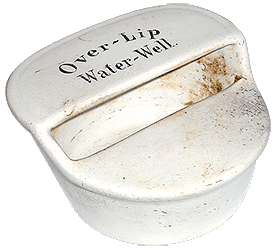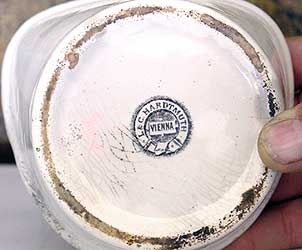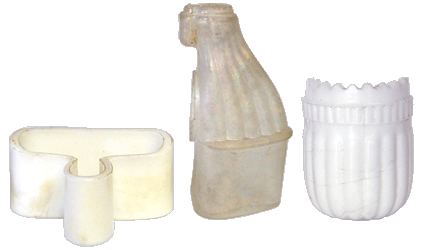
Bird Feeders / water fountains. The milk glass specimen on the Left is embossed PAT. OCT. 27. 1875. and on the right is a more recent model with no embossing.
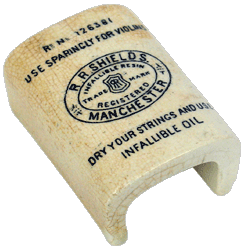
R. R. Shield's Infallible Resin was used extensively for oiling violin strings. Also known as Bow Wax.
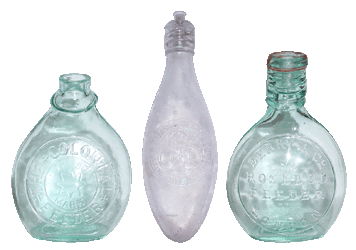
Much has been written and recorded about baby feeders. On the Left is a Tye Colonial, middle an embossed S. Maw. Son & Sons England and is graduated with measurements for 18 tablespoons, right is a Berry & Co Rosebud Baby Feeder. 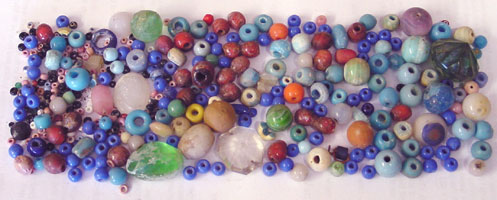
A selection of beads and
baubles accumulated over a period of years. The observant
browser may spot a glass cameo and a Teddy Bears eye.
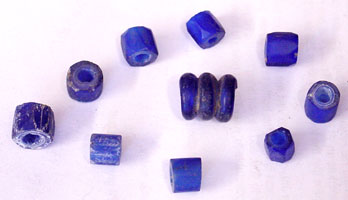
This is a selection of hand made blue glass "slave
beads" found on a farm just outside Warmbaths.

Glass, Bone and Mother of Pearl buttons
from the turn of the century.
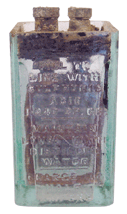
A lead acid battery circa
1915 crisply embossed FILL TO / LINE WITH / SULPHURIC / ACID
/ 1.24O SP. GR. / MAINTAIN / LEVEL WITH / DISTILLED / WATER
/ CHARGE AT / HALF / AMPERE
This battery still looks as if it could give you a nasty shock!

Candlestick holder and candle snuffs. Candle snuffs come in a variety of colours and styles. The holders are rarely dug whole (the one pictured has been reconstructed by Antique Bottles).

Piano Caster Protectors are very collectable and are found in a wide variety of colours and designs. The one on the right above was dug and pictured centre is a castor wheel. The weight of a piano, organ, table or even desk could have badly damaged Victorian carpets were it not for these protectors.

Six clay pipes, often found
on a dig, clay pipes were freely available in bars and were
usually used to advertise certain drinks. Easily broken and
readily thrown away, certain U.K. collectors specialise in
clay pipes.
Left to right: A rather plain design, Harp Crown
& Shanrock, Blankenhyms Genever is De Beste, American
Flags with Eagle above, Elephant & palm trees and Victoria
Crown.

Codd Openers were manufactured mainly from wood to facilitate opening Codd bottles, depressing the marble whilst ensuring that the spray was deflected. 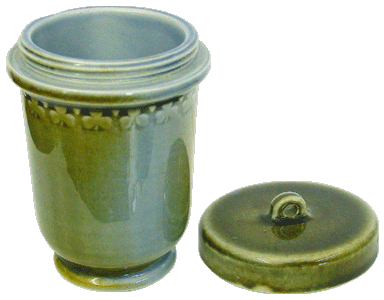
Egg Coddler used at the turn of the previous century to poach eggs. A digger may occassionally come across the top section with its string loop, however it is unusual to find both pieces intact.
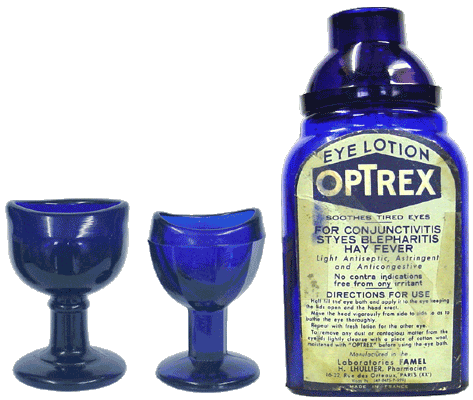
A pair of cobalt blue glass Eye Baths. Highly collectable and much sought after in the U.K. some specimens ( neither of these pictured!) fetching up to £500. On the right a more recent eye wash kit consisting of Eye Bath and eye lotion.
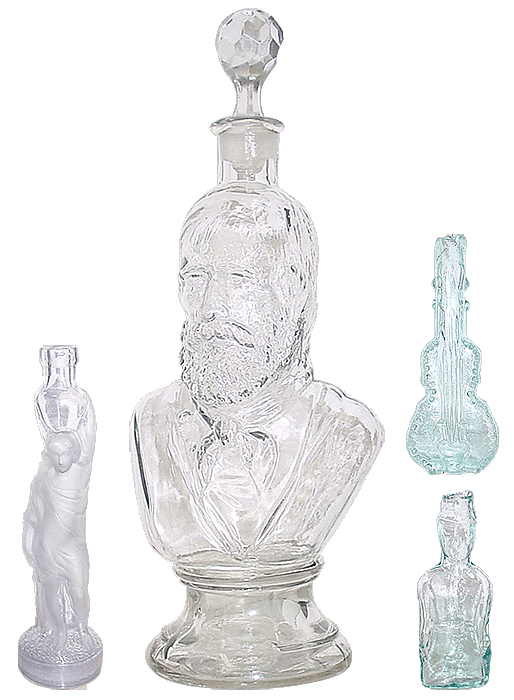
A nice selection of figural bottles. On the left, a lady carrying a water pitcher. In the middle a pontilled decanter with ground glass stopper (not sure who the face belongs to?). On the right, an unusual Violin figural bottle and a policeman ink/sherbert. We hope, soon, to have his partner, a robber.

LILLICRAP'S HONE. An unusual brilliant green coloured glass item with lots of embossing and patent numbers underneath. Lillicrap's Hone, obviously used to sharpen something was "patented throughout the world" even in S. Africa (patent no. 140/31). Thanks to
Tony Edmonds of the U.K we now know it was used to sharpen double edged
safety
razor blades.

Inhalers were all the rage at the turn of the century and are very collectable. Some could still even be used today. In the centre is a picture of what we presume to be the stopper of an inhaler although how exactly it worked we are not sure. On the ends are two different viewpoints of the same inhaler.

The ingenious design of these Spill Proof Ink Wells made it impossible to spill any ink even upon 180 degree rotation (it also makes it very difficult to clean the bloody things!). 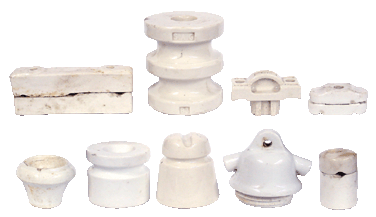
Unlike their American counterparts (see glossary) South
African insulators are made of
ceramic material and are relatively mundane and while being
interesting, not at all collectable.
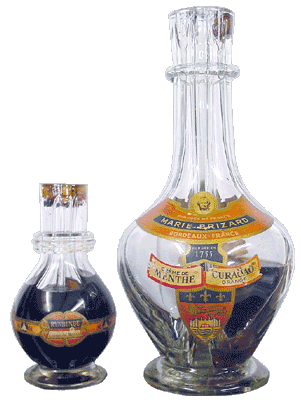
Although not antique, these liqueur
bottles are unique in their construction as 4 in 1 samplers
of the products on offer from (L) Rynbende and (R) Marie Brizard
Bordeaux. Purchased 1 May 2003 these bottles typify the type
of item which one should always on the lookout for and which
will soon qualify as "collectable"
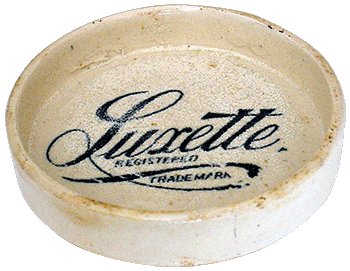
I have absolutely no idea what this shallow dish could have been used for. 
I must have
dug more than 20 measuring spoons in the last 20 years. All of them were broken... why would
anyone throw a whole one away?
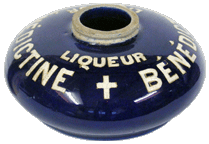 
This Bendictine Liqueur advertising piece was a miniature oil lamp, sadly the superstructure is missing. The picture on the right shows a restored example.

Here is an ornament made out of 42 coloured marbles, which means 42 broken Coloured Marble Codds "OUCH"

Padlocks are some of the brass items which weather well in Victorian dumps and some of which seem as if they could still be used today. The Boer War padlock on the right bears numerous inscriptions. Click to enlarge last padlock.
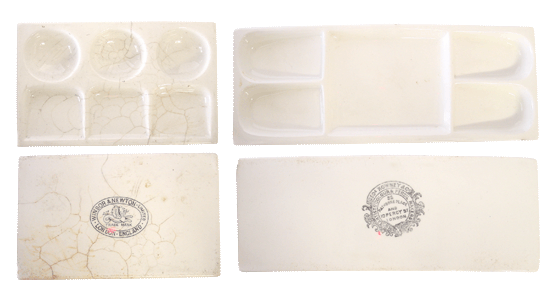
Water Colour Palettes used for mixing water paints. Winsor & Newton is still manufacturing paints and pigments today.

A recent but attractive miniature (working) paraffin lamp 109mm
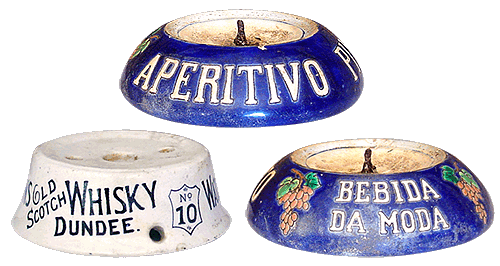
These curious pedestials were obviously designed to hold or support something but I do not have the faintest idea what! (doubtless some kind soul will elighten me)

A group of late Victorian Pie Funnels used in baking to support the crust whilst enabling steam to escape. From the left: Bird Pie Funnel marked 809618, Elephant Pie Funnel Nutbrown made in England Regd. No. 880829, Pedestal "The Gourmet Crustholder & Vent. Challis Patent". Bird on Log (unmarked) and Bird on plain base (unmarked). Note how the heights of the crust-bearing areas are much the same.  
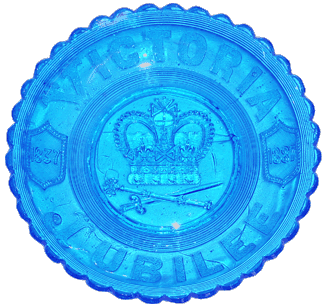 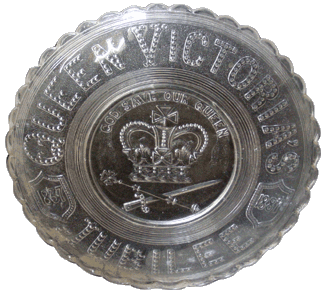

The above pressed glass commemarative plates and bowls would not normally feature in an antique bottle collection however I have it on good authority that there have not been any copies nor reproductions of these exquisite pieces and after having dug numerous shards of the blue plate at Galeshewe I have decided to include these truly remarkable Victorian momentos. Hopefully her Majesty will forgive me for including her plates in the Odds and Sods section (no offense meant Ma'am).
The clear plates were photographed on a black granite background as to bring out the embossing. 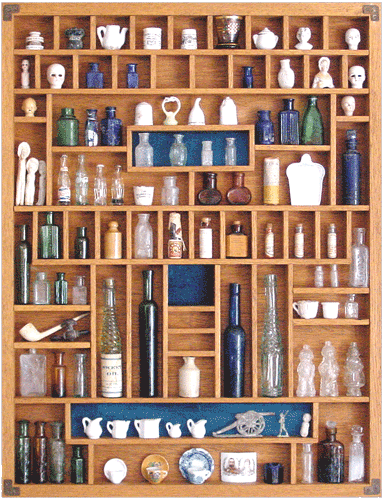
selection of "smalls" arranged in a modern day printers tray type frame. A large number of smaller items which one might find on a dig cannot really be clearly categorised. Pictured above are a variety of bottles and dump finds. 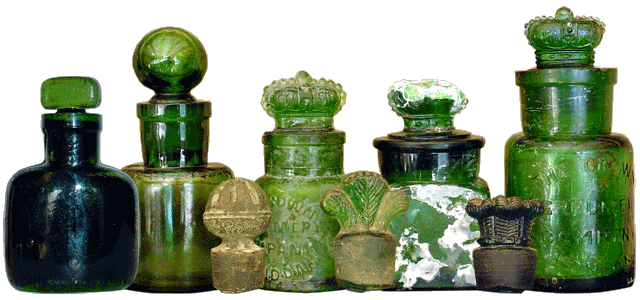
Smelling Salts were popular during Victorian times for reviving ladies subject to fainting spells or who needed to recover from a shock. Almost always in green these bottles are highly collectable, very attractive and come with a wide range of different stoppers.
From left to Right An unknown smelling salt, Dr. Mackenzies smelling bottle, The Crown / Perfumery / Company / London, Unmarked but with crown emblem on base, The Crown / Perfumery / Company / London larger size and a bottle bearing the incription Rd No 417253 made in England.
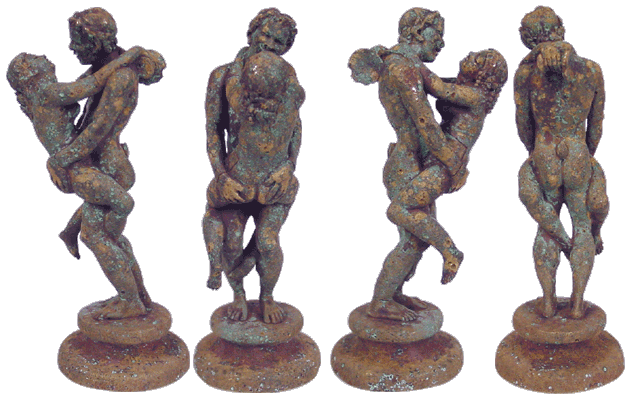
What makes this erotic solid brass two piece cast statuette, overall height 175mm, even more remarkable is its age! It was recovered from the now famous "Gilbertsons dump" outside Kimberley and was thrown away between 1875 and 1880. It owes its excellent condition to the fact that it was wrapped in several layers of cloth material and that Kimberley is a notoriously dry town. This piece bears no markings and any information on it would be appreciated.
Taps, nearly always made of brass, are amongst the most long-lasting artifacts which may still be found in a dump.
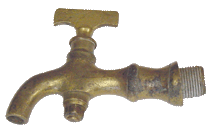
A fairly plain tap with unusual-offset threaded portion.
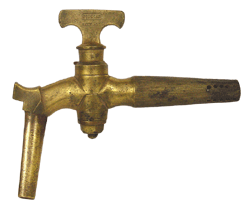
This is the FIDDIAN "SAVE ALL" Classical Tap Click for enlargement.
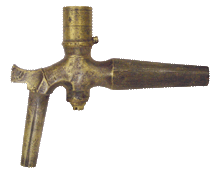
This tap embossed across the nose MARTINEAU & SONS employed a unique anti theft handle.
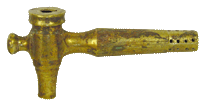
Another tap using an anti theft device. Click for enlargement.

A gas tap with CB embossed on ther handle click for exploded view.
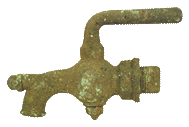
An unusual tap in the state in which it was found (dug) keep watching for the cleaned and working version
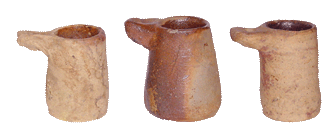
Bird (Canary reservoirs). Mainly found in mining towns (these all from Kimberley). The three pictured above held, from left to right, 20ml, 37ml and 22ml when filled to the brim. Thanks to Roger Pellow for solving the mystery to what there are. 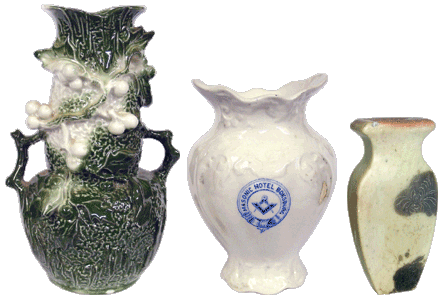
A beautiful soapstone hand crafted vase dug at Forrest Hill Johannesburg. Made by immigrant chinese mine workers. The green vase with holly motif is amazingly in one piece and in perfect condition c 1920, it was dug at Forest Hill. The white vase, also c 1920 had a small hole (not me!) and was found at Boksburg1.
An Over-Lip Water-Well which was probably used in a church to contain holy water.

|














































